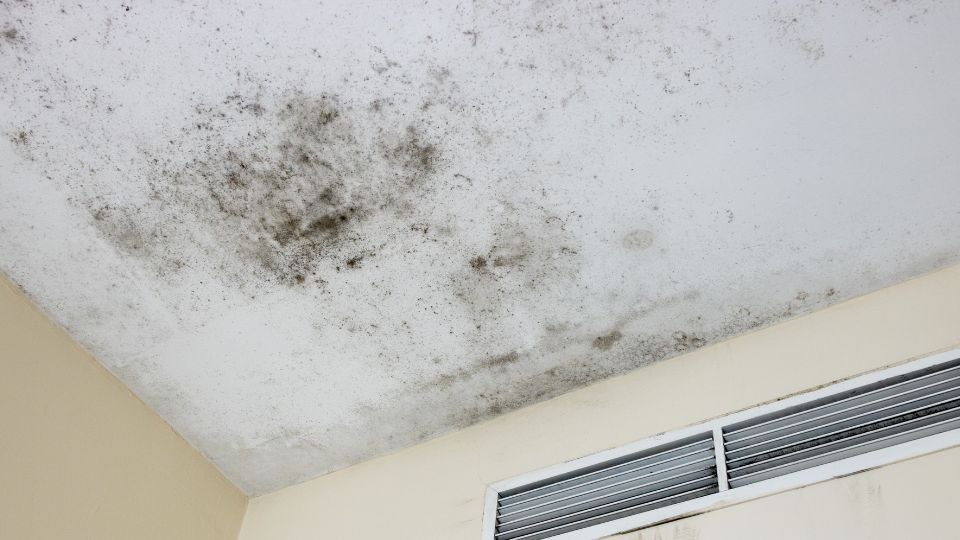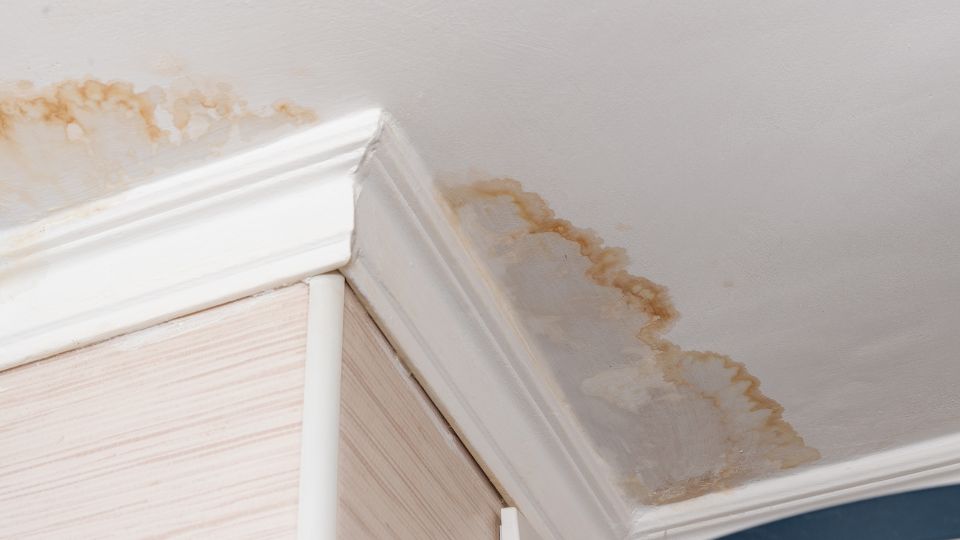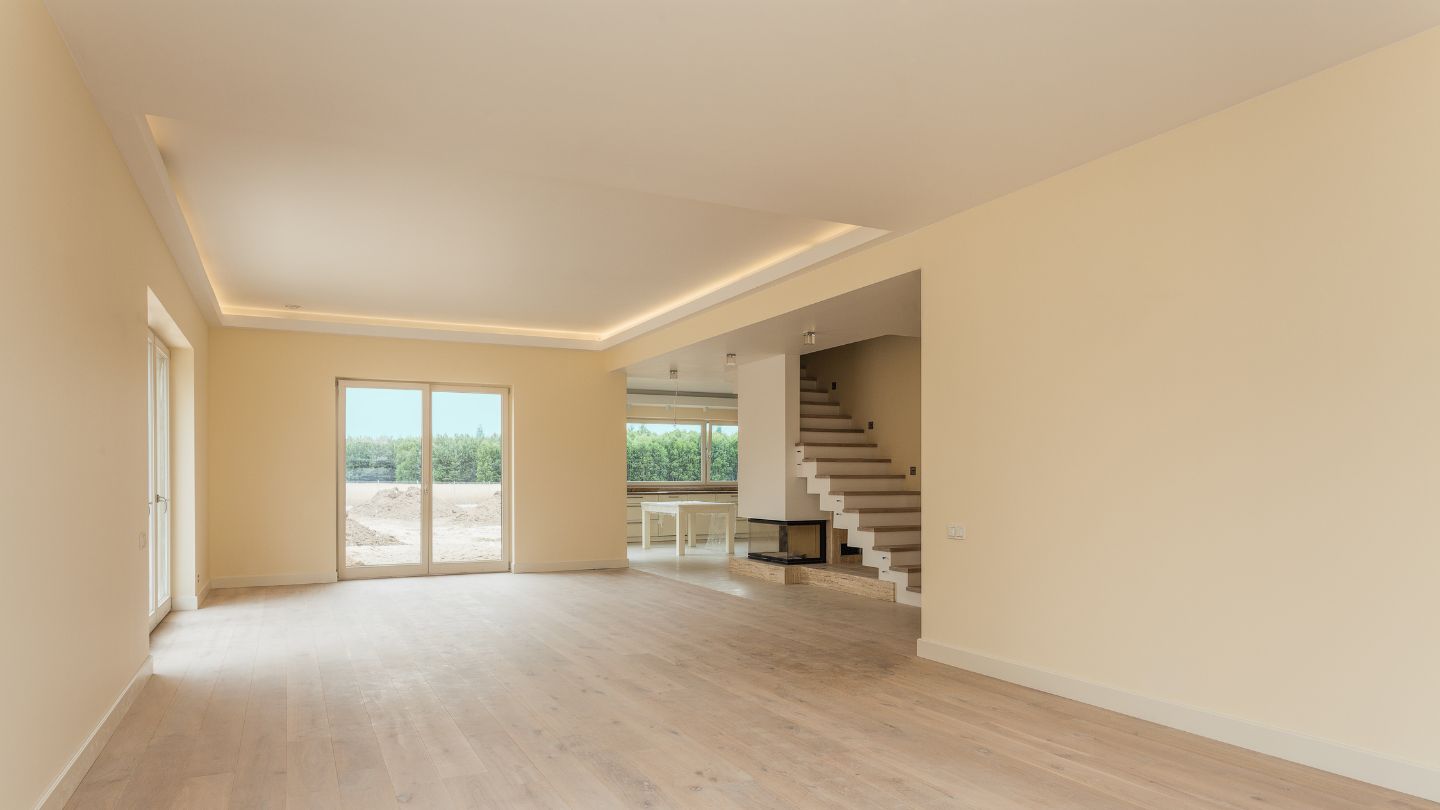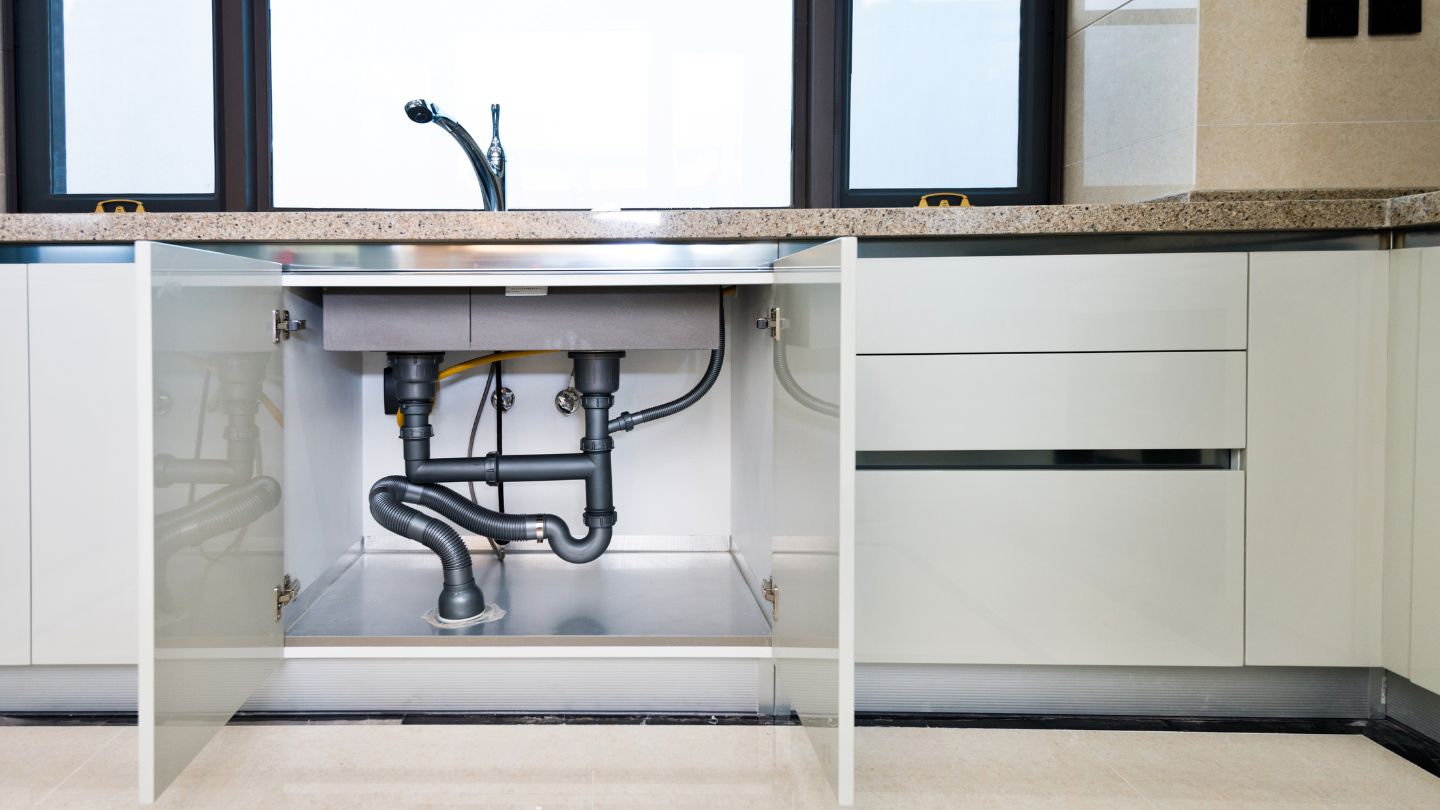
by Mold-B-Gone | Jan 9, 2024 | Mold Facts
Have you ever wondered if a small roof leak could escalate into a major mold issue in your home? Many homeowners underestimate the impact of roof leaks and mold, but the truth is startling. This blog addresses the nitty-gritty of how mold in ceilings from leak situations can be more than just a nuisance.
Causes of Roof Leaks
At the heart of this issue, understanding the causes of roof leaks is crucial. A common misconception is that roofs are highly durable and invincible against external factors. However, the materials are more susceptible to damage than one might think, leading to leaks.
Besides human activity, nature plays its part. The U.S. averages about 30 inches of rain yearly, putting immense strain on roofs and gutters. Clogged or damaged gutters fail to divert rainwater adequately, resulting in water damage and, potentially, mold from roof leak scenarios.
Another significant factor to consider is the condition of your shingles. They are your home’s first defense line against harsh weather, but over time, they can succumb to wear and tear, leading to leaks.
What to Look for to Identify a Leak
Detecting a roof leak early can be a game-changer in preventing mold in your apartment or house. The most obvious sign is a water stain on your ceiling—a discolored, often brownish puddle shape. However, not all leaks are that conspicuous. Sometimes, they manifest as a subtle drip from the ceiling or even as organic growth, like moss, on your exterior walls.
How Leaks Escalate to Molds
Moisture from leaks creates a perfect breeding ground for mold. If the issue is in the attic, condensation can be the primary culprit. The real concern is the speed at which mold can spread. It can start from a small area and rapidly infest other parts of your home.
Black mold is particularly notorious for posing severe health risks. Hence, addressing leaks promptly is vital to safeguarding both your home’s integrity and your health.
Read more: Why Is Black Mold A Health Concern?
The Bottom Line: Prompt Action Is Key
A leaky roof can cause mold, and the implications are significant. Timely detection and repair of roof leaks are essential in preventing mold growth and its consequent hazards. Remember, addressing a leak today can save you from a mold nightmare tomorrow.
Ready to Tackle Mold in Your Home?
Reach out to Mold-B-Gone Remediation, the mold remediation experts in Atlanta, for exceptional service and peace of mind. Don’t let mold take over your space—we’re here to help.

by Mold-B-Gone | Jan 2, 2024 | Mold Facts
Water leaks in your home, no matter how minor they might seem, can be a significant concern. The primary reason? The risk of mold development. Mold finds a haven in moist environments, and a one-time water leak, if not addressed swiftly, can escalate into a serious health hazard for your household.
Here’s an in-depth look at preventing mold growth following a one-time water leak, ensuring your home remains a safe and healthy environment.
Rapid Response Is Key to Mold Prevention
The speed at which mold can grow from water damage is alarming. Mold spores can start forming within 24–48 hours following water damage, a period often shorter than the time it takes to dry out affected areas completely. Enhancing air circulation and having cleaning tools at the ready can significantly reduce the risk of mold development.
Health Risks of Mold from Water Leaks
Mold, particularly types that flourish due to water leaks, can pose severe health risks. Some of these risks are:
- Exposure to mold in early childhood has been linked to an increased risk of asthma, and adults are not immune to its effects.
- Molds produce mycotoxins, which can trigger adverse immune responses and cause lasting respiratory issues.
Read more: What Are The Top 3 Water Damage Hazards?
Understanding these risks is crucial for effective mold prevention after a water leak.
Steps to Prevent Mold After a Single Water Leak
- Act Quickly: The CDC advises cleaning up within the first 24–48 hours post-flood to hinder mold formation. Even a minor leak can have similar consequences, necessitating immediate action.
- Clean and Dry the Area: Drying out the leak area is vital as mold thrives in damp conditions. Employ fans for air circulation and open windows if possible. Cleaning the area, even without visible spores or growth, is critical. Professional help might be required on porous surfaces like carpets or wood.
- Control Humidity Levels: High humidity is a breeding ground for mold. Use dehumidifiers to lower humidity in the affected area, and consider a humidity gauge to monitor and manage the levels effectively, reducing the likelihood of mold growth in the attic or other areas.
- Ongoing Vigilance: Post-cleanup, continuous monitoring is essential. Mold can remain dormant and reactivate under favorable conditions. Keep an eye on humidity levels and be alert to musty odors, signs that mold might still be present.
Final Recommendations
Understanding the risks and steps for water leak mold prevention is crucial. While mold from a one-time leak can be managed effectively, being proactive and vigilant is key to ensuring your home remains a healthy environment. Trust Mold-B-Gone Remediation, your mold remediation experts in Atlanta, for all your mold prevention and remediation needs.

by Mold-B-Gone | Dec 9, 2023 | Mold Facts
Mold is a persistent challenge in the construction industry, especially in new buildings where the combination of heat, water, and organic materials creates an ideal breeding ground for this unwelcome guest. This blog outlines practical and straightforward strategies for keeping mold in new construction homes at bay.
Proactive Measures for a Mold-Free Environment
The first line of defense against mold in new construction is ensuring the building is watertight. This process, known as ‘drying in,’ involves meticulous sealing of the building’s envelope to prevent water ingress. Key actions include installing a water-resistant roof, employing watertight exterior siding, fitting watertight windows, and sealing all potential entry points around windows, doors, and other openings.
Handling Construction Materials with Care
Many construction materials, like wooden frames and subfloors, can absorb moisture during wet weather conditions. It’s crucial to allow these materials adequate time to dry out completely before proceeding with the drying-in process. Ignoring this step can lead to trapped moisture within the structure, creating a fertile ground for black mold and other fungi to thrive.
Addressing New Sources of Humidity
Even with effective drying-in, new construction can still face mold challenges from additional moisture sources introduced during the building process. For instance, renovation activities like asbestos or drywall removal often require water usage, increasing indoor humidity. In such scenarios, the use of dehumidifiers can be a game-changer, helping to maintain a dry environment that is conducive to preventing mold in new construction.
Read more: How Mold Grows in Different Humidity and Temperature Conditions
Understanding Mold Growth Dynamics
In the early stages of construction, using non-organic materials such as metal and concrete alongside fresh hardwood reduces the risk of mold growth. However, once softer, organic materials like ceiling tiles and drywall are introduced, the risk escalates. These materials provide the perfect conditions for mold to develop, sometimes in as little as 48 hours after exposure to moisture.
Thorough Pre-Installation Checks
Before installing drywall or other susceptible materials, it’s crucial to ensure everything within the building’s structure, including windows, siding, and roofing, is properly sealed. Additionally, verify that all wooden elements are fully dry to prevent potential mold growth.
Contingency Planning for Project Interruptions
Unexpected interruptions, like adverse weather or funding issues, can halt construction or renovation projects. In such cases, it’s vital to dry and seal off as much of the construction as possible. Installing dehumidifiers can help maintain a dry environment, serving as one of the ways to remove mold from new construction.
Get Expert Mold Solutions Today
Looking for a reliable mold removal service in Atlanta? Contact Mold-B-Gone today, and let our team of professionals ensure your home stays mold-free and healthy. Trust us for top-notch service and peace of mind.

by Mold-B-Gone | Dec 6, 2023 | Mold Facts, Mold Removal
Understanding what mold mites are is crucial for anyone grappling with mold issues. These tiny, spider-like creatures are not just common in damp environments, but they thrive on mold, making them a frequent concern in homes with moisture problems.
Are Mold Mites Dangerous?
While they don’t bite or directly harm humans, their presence can significantly degrade air quality. This becomes particularly problematic for individuals with allergies or respiratory issues, as mold mites can exacerbate these conditions.
Read more: How Do I Know If I’m Allergic To Mold?
Distinguishing Mold from Other Fungi
In tackling mold mite issues, understanding the difference between mold and fungus is important. While all molds are fungi, not all fungi are molds. Mold is a specific type of fungus that creates a more hospitable environment for mold mites. Thus, distinguishing the two helps in targeted remediation efforts.
Steps to Eliminate Mold Mites
The key to getting rid of mold mites effectively is to address the root of the problem: mold. Mold mites feed on mold, so eliminating their food source is crucial. This can be done by doing the following:
- Identifying mold-infected areas: Look for spots with discoloration or a musty smell, typically in damp places like basements or under sinks.
- Cleaning the affected areas: Use mold-killing solutions such as bleach or vinegar to clean these areas thoroughly.
- Improving air circulation: Use fans or dehumidifiers to reduce moisture in the air, making it less conducive for mold and mold mites to thrive.
- Regular inspections: Keep an eye out for early signs of mold to prevent reinfestation of mold mites.
Preventive Measures
Prevention is always better than cure, especially with mold mites. Regular cleaning, reducing humidity levels, and promptly addressing any water leaks or dampness can significantly reduce the risk of mold and mold mite infestation. This includes:
- Using dehumidifiers in moisture-prone areas.
- Ensuring proper ventilation, especially in areas like kitchens and bathrooms.
- Fixing leaks and addressing condensation issues promptly.
- Keeping the house clean and free from clutter where mold can easily grow.
Get Expert Help with Mold Mite Removal
Don’t let mold mites signal a larger problem in your home. Take control of your indoor environment with Mold-B-Gone Remediation, your trusted mold removal specialist in Atlanta. Our team is dedicated to ensuring a healthy, mite-free living space for you and your family. Whether you’re dealing with a severe infestation or have specific mold sensitivities, contact us, and we will provide comprehensive solutions tailored to your needs. Remember, regular maintenance and professional expertise are your best defense against mold.

by Mold-B-Gone | Nov 10, 2023 | Mold Facts
Living in a place like Atlanta, Georgia, with its humid climate, can pose unique challenges for homeowners, particularly when it comes to maintaining indoor air quality. One often-overlooked issue is the presence of mold under carpet. Mold can significantly impact your health and home environment.
Recognizing Signs of Mold on Carpet
Understanding what mold looks like on carpet is crucial for early detection. Initially, mold growth might not be visible, but a musty odor can be a tell-tale sign. This odor comes from the microbial volatile organic compounds (MVOCs) released by mold as it grows and reproduces. If you detect such odors, you should act swiftly and test for mold.
Eventually, as mold grows, it will become visible, appearing as green, white, or what black mold looks like on carpet—typically black spots. This visibility indicates a significant growth issue that needs immediate attention.
The Health Implications
You might be surprised by how fast mold grows on carpet, especially in humid conditions. Various types of mold, some of which are potentially toxic, can lurk unseen. Exposure to these molds can trigger a range of symptoms, from allergies to serious respiratory conditions, especially in sensitive individuals like children, the elderly, and those with pre-existing health issues.
The presence of moldy carpet in a home can be identified through symptoms such as asthma, coughing, eye and skin irritation, sneezing, sore throat, and a stuffy nose. In extreme cases, prolonged exposure to mold can lead to more severe health problems, such as depression, anxiety, and even memory loss.
Solutions and Prevention
Prevention is key when dealing with carpet mold. Ensure good ventilation and humidity control in your home, particularly in areas prone to dampness. If you do encounter mold, considering a professional mold removal service in Atlanta is advisable.
Regular cleaning plays a crucial role in mold prevention. Dirt, a carrier of mold spores, along with moisture, can accelerate mold growth. Vacuuming 1–2 times a week and professional deep cleaning every 12–18 months are recommended. However, if mold has already set in, cleaning might not suffice. At this stage, removal and replacement of the carpet, along with possible repairs to the underlying floor, are necessary.
Hidden Mold Locations
Apart from your carpet, there are other places mold hides in your home. It can lurk in damp basements, under sinks, or in any poorly ventilated areas. Regular inspections of these spaces are crucial for early detection and prevention.
Protect Your Home With Expert Help
Do not let mold compromise your home and health! Contact Mold-B-Gone for expert mold removal and indoor air quality solutions in Atlanta and beyond.

by Mold-B-Gone | Oct 23, 2023 | Mold Facts, Mold Removal
Mold is more than a mere aesthetic concern; it’s a sneaky infiltrator that brings a range of health problems, from respiratory issues, skin irritation, and allergic reactions to red, itchy eyes. Not only that, but mold also endangers the very structural foundation of buildings, making it a vital concern to address promptly and effectively to safeguard both people and properties.
Hence, timely interventions, like availing of a mold removal service in Atlanta, can be critical in managing and mitigating mold issues.
The Role of Air Purifiers in Battling Mold
It’s a common query: do air purifiers help with mold? The short answer is yes, they do, but with certain limitations. Air purifiers, especially those equipped with HEPA filters and UV-C technology, are proficient in capturing mold spores, preventing them from proliferating and spreading across your living spaces.
This means that while an air purifier helps with mold in terms of curbing airborne spores and maintaining air quality, they’re not a full-fledged solution for established mold infestations.
Read more: Indoor Air Quality: Why It Matters and How to Improve It
In the Ducts: A Different Mold Story
However, there are situations where even the most efficient air purifier struggles. If you’re thinking, “Can an air purifier help with mold in my air ducts?” it’s crucial to understand that mold in air ducts presents a unique challenge.
Once mold secures a foothold in this hidden area, fueled by accumulated moisture and debris, it can disperse spores throughout your space even as you breathe what you believe to be purified air. Therefore, while air purifiers can assist, they are not capable of rectifying mold issues within ductwork, and a professional cleaning service becomes indispensable.
The Limits of Air Purifiers in Mold Mitigation
It is pivotal to grasp that while air purifiers help with mold spores and contain the airborne spread to an extent, they don’t address the root cause or eliminate established mold colonies. Will an air purifier help with mold completely? No.
To eradicate mold, a combination of thorough cleaning, preventive practices, and strategic remediation, like managing humidity, fixing leaks promptly, and enhancing ventilation, is essential. Utilizing air purifiers should be seen as a supplementary preventive measure, not a solitary solution to a mold problem.
When the situation slips beyond what air purifiers can manage, that’s when specialists step in. Mold Removal Service in Atlanta, with a track record of securing thousands of homes in Atlanta from mold perils, steps in as your shield against mold infestations. Get in touch with us now and step into a future free from mold worries!






